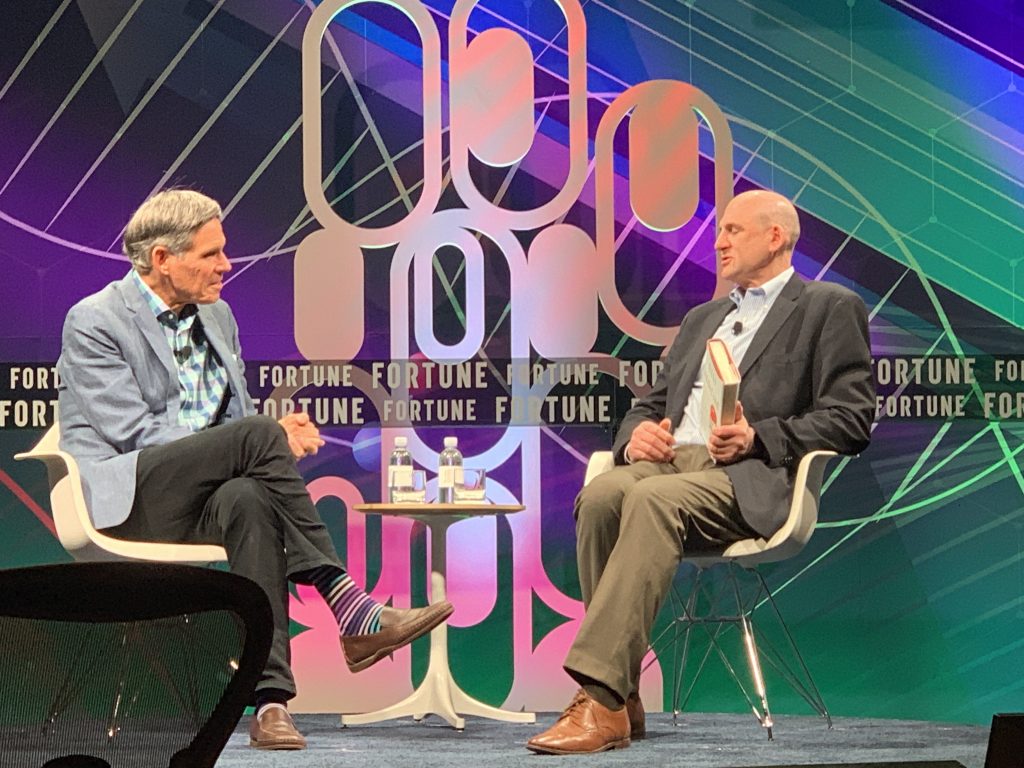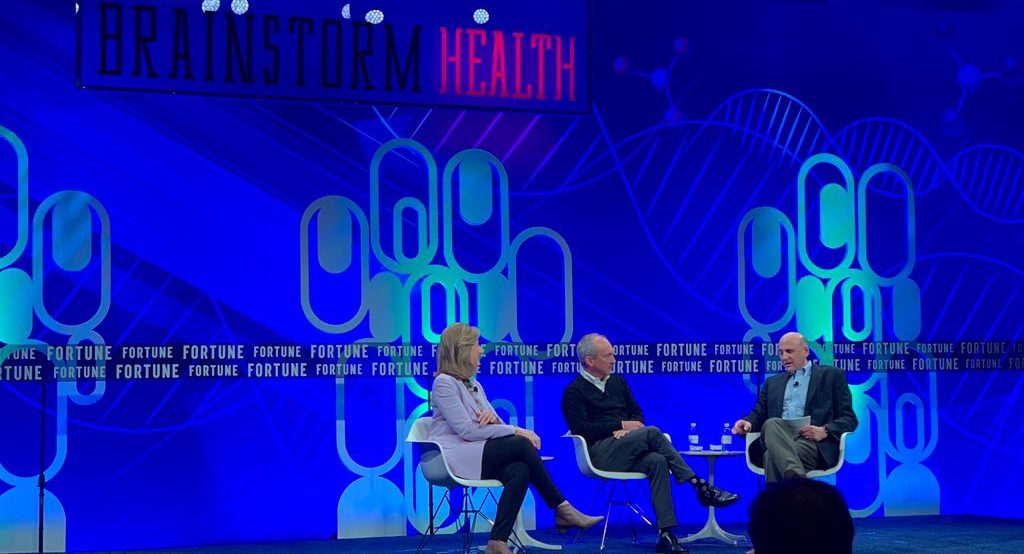I’ve just attended this years Fortune Brainstorm Health event in San Diego, where the theme was Health’s Bottom Line, and how the various inputs and outputs at both an individual and society level had the potential to impact on the end patient outcomes.
For me though there were two major streams of thought that I took away. One was the increasing focus on ‘upstream’ actions as Co-Chair of the conference Arianna Huffington refers to them – the things that cause and impact on lifestyle conditions, and how to reduce their impact and create flow on benefits to both individuals health and the ever escalating cost of the US healthcare system. With sleep, diet and stress all occurring primarily outside of the clinicians environment, understanding those elements is key to helping patients achieve better health outcomes.
The second was far less positive, and it was the sense of almost despair about just how serious the deep rooted issues the US electronic medical record (EMR) system has created are. There is a fantastic article in the current Fortune magazine (click here to read it) that goes into what these issues are, but so many of the conversations over the two days, regardless of the topic at hand, kept coming back to the lack of portability, lack of search ability, and lack of access to meaningful insights that these systems have embedded into the day to day reality of US healthcare. The only thing it seems they don’t lack is the ability to suck up clinician time, with many doctors spending more time entering data than they do actually seeing patients, and the term ‘pyjama time’ (where clinicians go home from work and spend hours late in the evening completing EMR records) becoming mainstream.
Now for my key takeaways on each of these thought streams.
Upstream actions are looking at how some of the fundamentals can impact on overall health, with a shift to ‘reconnect the head to the body’ as Bernard Tyson, CEO of Kaiser Permanente put it. Conversations included starting with an understanding of the importance of the role sleep plays in our overall health, to working on programs that see mental healthcare more tightly integrated into general healthcare environments, to how patients can gain an understanding of which foods they should actually be eating in this world where we’re bombarded with information on whether foods are ‘healthy’ or not – and of course the increasing impact that we’re seeing created by people spending hours every day on their phones. As Catherine Price, science journalist and author of How to Break Up with your Phone, so simply but eloquently put it – on average we are spending four hours per day on our phones – spending that amount of time per day on any activity unequivocally produces changes in our brains, so why are we surprised that our addiction to ‘screen time’ is having consequences.

Those mobile devices aren’t all bad though, with providers all talking about the opportunity they delivered to bring healthcare out of institutions and into people’s homes via telemedicine and monitoring applications. This also sparked an interesting conversation about how investing in technology to deliver and manage these kind of services requires a different cost structure and business case to building and staffing a new medical centre, and how do we go about capturing the lifetime cost/benefit of new technology based models is vs the more easily quantified historical bricks and mortar approach.
There was sobering acknowledgement that no matter what other measures are put in place, the two factors that still have the most overwhelming impact on health status are postcode and skin colour, with Dr Barbara Ferrer, Director of LA County Dept of Public Health, stunning the audience with the awful statistic that babies born to black American mothers are 4 times more likely to die than those born to white mothers, regardless of socio-economic status. Until these fundamental issues of inequality are addressed as broader society measures, there is always going to be a significant percentage of the population who don’t get the opportunity to live a healthy life.
Another worrying trend with significant ‘upstream’ implications was the rapid rise of vaping or e-cigarettes. Twenty four percent of high school students are now using these products, which is more or less the same figure who used to smoke cigarettes before public health programs saw that number reduce to less than 4%. Teen-aimed fruity flavourings are helping to drive this rapid uptake, and while the long term health impacts of the carrier vehicles are not as well quantified as the impact of cigarette smoke is, the negative impact of nicotine on the teenage brain certainly is. With cigarette companies acquiring vaping brands, the Marlboro man may be riding a different horse these days but one that is not any less inadvisable to mount.
Now to the EMR conversation…..Australia is still very much in it’s infancy when it comes to EMR’s or EHR’s (electronic health records or electronic medical records). Most doctors and health care professionals use some kind of patient management system (PMS), but these are usually isolated to their own practice records with the exception of often also including pathology and radiology results. The governments My Health Record is designed to address this, but is still a long way from having a functional impact on day to day healthcare.
Australian hospitals have historically operated on paper based clinical notes and charts, with digitised information focused on billing and activity related aspects of care, although state governments have been funding the roll out of EMR systems across public hospitals systems in recent years. With the two systems being deployed in Australia being Epic and Cerner, the two largest EMR providers in the US market, it was pretty confronting to hear what our future could also look like if we don’t take measures to ensure we learn from the mistakes made in the US.
Admittedly one aspect that has played a substantial role in the burden EMR’s have created in the US is the vast amount of information required to be entered by physicians to meet billing requirements. As the US grapples to find solutions to it’s problems, studies have identified that the volume of notes entered in these same systems in markets like Australia and Singapore is only around 30% of the volume seen in the US, so that’s something at least.
That doesn’t resolve some of the other key challenges though, in that key information is not easy to find or obvious which, as illustrated in the Fortune article linked above, can directly impact on care outcomes. The lack of structure and lack of requirement for use of standard terms is hampering the ability to unlock meaningful insights from the data, alongside the reality that these systems have been designed to lock data in rather than readily share it.
There are vast volumes of unstructured data that exist in disconnected EMR’s all over the country, and many of the speakers spoke of their belief that AI is the only way to gain meaningful insights. As Dr Topol said, ‘deep learning has an insatiable appetite for data, while human satiety occurs much earlier’.
So many lessons to learn as not only Australia but the wider ASEAN region embarks on it’s own healthcare digitisation journey, let’s hope those in charge of rolling systems out here take the time to understand the pitfalls and potholes of the US experience rather than blindly following down the same road. I know it’s something that’s absolutely front of mind for us at Icon Group, and as always I appreciated the insights that the Fortune Brainstorm Health event provided not only in the onstage conversations but in the offstage chats.
Everyone agreed that AI was the great hope for solving some of these issues, with increases in compute power and reductions in technology costs making potential solutions achievable when they haven’t been previously. Dr Eric Topol spoke of his belief that AI will truly be the game changer, and will give physicians the time to go back to practising old-style medicine, where they speak to their patients rather than spend all of their consult time entering information into EMRs. He also spoke about the need for AI enabled decision making support, augmented intelligence rather than artificial, and that future generations of doctors will see this as a standard part of the way they practice rather than something to be threatened by.

There are lots of great summaries of the content delivered available here on the Fortune website, and as always I’m interested in your thoughts on these sometimes contentious topics.
